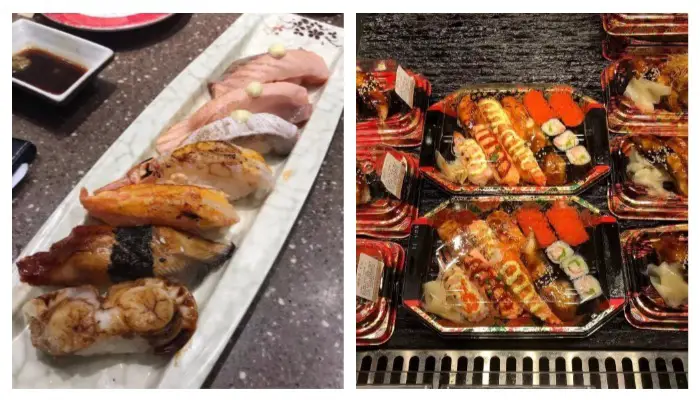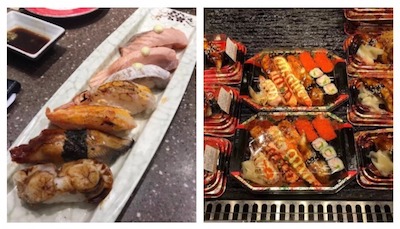We are reader supported. When you purchase through links on our site, we may earn an affiliate commission. Also, as an Amazon affiliate, we earn from qualifying purchases.

Several years ago, my friend introduced me to authentic makizushi prepared by a master chef in a sushi bar. So, when I saw pre-packed sushi available as cold snacks at the grocery stores, it confused me. I wondered – how can the same food vary so widely in terms of quality, price, and presentation?
After eating sushi in numerous restaurants and even guilty of snacking on grocery store sushi, I can now tell the difference even if I am blindfolded. So, I decided to dedicate this article to explain the difference between the two for the beginners and the curious.
Is Grocery Store Sushi Good For You?
Let’s start with grocery store sushi which is a common sight at supermarkets, malls, gas stations, and of course grocery stores. When you stop by the store to buy a few things on your way home from the office, it’s hard to not give in to the temptation of sushi. It sits pretty on the shelves and you can’t say ‘No’ when your stomach is growling with hunger.
You ask ‘why not?’ After all, the grocery store sushi is less expensive, only about $10 a plate while the restaurant sushi costs $30 or more per plate. Moreover, it looks fresh and healthy so why the difference between grocery-bought and restaurant sushi?
Well, the real difference is not evident by looks alone but becomes clear when you take a bite. The grocery store sushi lacks the flavor and texture of freshly made sushi. The fact is both these types of sushi have the same quality ‘at a point of time’. However, the restaurant sushi is served to you immediately while the store-bought sits on the shelf for a long time until someone buys it.
The longer sushi sits on the shelf, the rice becomes harder and slowly starts to separate. The Nori strip, whether it is outside or hidden inside the roll, loses its crispiness and becomes mushy. The fillings and toppings including raw fish, vegetables, and fruits also lose their texture when left in the refrigerator for too long.
Where Does The Grocery Store Sushi Come From?
These are pre-packaged sushi prepared in a company and they are then distributed in a controlled manner to different grocery stores and supermarkets in the cities. The sushi is refrigerated to ensure that the food stays healthy for consumption.
They have an expiry date mentioned at the back of the label, which tells you by when you should consume the sushi. If for some reason you forget to eat the store-bought sushi before that date, I would strongly recommend that you toss it out.
Fuji Food Products Inc is one of the largest companies selling pre-packaged sushi. They distribute packaged sushi to more than 4,000 grocery stores in over 44 states in the USA. The sushi is made in a company-owned facility and then it is sent to different locations in a fleet of fully refrigerated trucks.
Why Is Restaurant Sushi Superior To Store-bought Sushi
In a restaurant, you get specialty rolls freshly prepared by the hands of a master chef right in front of your eyes. Watching the chef cut perfect slices of fish, bind it with rice and other ingredients to create a masterpiece is an enthralling experience in itself.
Furthermore, at a sushi restaurant, you are not limited in terms of choice. You can have multiple varieties of fish and seafood toppings. If you are a vegan, you are still spoiled with choices, as there are a plethora of seasonal vegetables and fruits in sushi.
I admit many of us are guilty of picking up grocery store sushi sometime or the other when we are in a hurry. However, here are a few differences that explain why you pay a heavier price for the sushi served at restaurants. Let’s discuss the differences in the main ingredients one by one:
Key Differences Between Grocery Store Sushi And Restaurant Sushi
The rice
The rice in store-bought sushi is either too mushy like baby cereal or as hard as bone due to prolonged exposure to cold temperature.
Ideally, sushi rice should be served at close to room temperature to enjoy the optimum flavor and this is possible only in restaurant sushi.
Furthermore, sushi rice used in the store-bought stuff is seasoned with an overdose of vinegar and sugar to make them last for long. This overpowers the taste of fish and other ingredients. At a restaurant, the chef takes care to mix rice, vinegar, and sugar in correct proportions for the best results.
The fish

Raw fish is flash frozen, but when the chef prepares sushi in front of you, the warmth of his hands softens the fish and enhances the flavor. The grocery store sushi lacks this personal touch and the fish lose flavor when chilled for too long.
Fish used in sushi making facilities usually come from big suppliers while the restaurants get them from the most trusted fishmongers who supply the freshest catch of the day. Although the fish used in store-bought sushi is high-grade, it may not be consistent in texture and flavor.
You know that fish caught in the ocean goes through some sort of freezing method before it reaches your mouth, however, the technology may differ widely. The upscale restaurants get fish only from sources that use the flash-freezing technology wherein a temperature of – 65 degree is maintained. You can have a look at this article for more info
Grocery store sushi often contains fish from sources that use cheaper freezing technology to keep the costs down. This results in water crystallization, which in turn degrades the overall flavor of the sushi.
Seasonal variations
The grocery store sushi lacks variety and you will typically find spicy tuna rolls or cucumber/ avocado rolls on the shelves. In a restaurant, the chef knows what’s fresh in the season and he can recommend different varieties of fish for you to try
The biggest problem with grocery stores and supermarkets is that their supply chain often mislabels fish. As a result, you don’t get the authentic flavor and texture. You won’t encounter this problem at the respected sushi joints where the chefs personally take care of the quality of fish.
The vegetables and fruits
It does not take a genius to understand the difference between freshly cut vegetables/ fruits and the ones that have been sitting on the shelves for a long time. Obviously, the latter lacks crispiness and this affects the overall taste and texture of sushi.
In a restaurant, the chef uses the freshest quality and in-season fruits that are at room temperature, unlike the store-bought ones that are frozen and cold.
The quality of seaweed
The seaweed is supposed to be dry and crispy, and the sushi chef may further toast it to enhance the crispiness. In a restaurant, the crispiness is retained because the sushi is served to you soon after the chef prepares it.
However, the fate of seaweed in store-bought sushi is different. Staying in contact with rice and other ingredients for too long make it lose its crispy texture.
Pickled ginger and wasabi
The pickled ginger has a purpose and it is meant to cleanse your palate so that you can appreciate the unique flavors of different types of fish. In a restaurant, the chef may serve sushi made of tuna, salmon, yellowtail, halibut, crabs, prawns, and other varieties. The pickled ginger is prepared in-house to help you appreciate each flavor.

The grocery store sushi usually comprises just one type of fish (tuna) so the pickled ginger loses its purpose. Furthermore, the pickled ginger served in the packaged boxes are mass produced and they tend to be much sweeter.
Just like pickled ginger, wasabi included in the pre-packed stuff is not made in-house, and it may also not be the real thing. Even if they use the original root, wasabi loses its flavor after 10-15 minutes so you don’t get to enjoy the authentic flavor.
In the high-end restaurants, the chefs may use the original wasabi roots like this to make the green sauce. Even if they use substitutes in the restaurants, the fresh stuff tastes much better.
The sauces
The store-bought sushi usually hides behind a zig-zag pattern of mayo sauce, which may overpower the flavor of raw fish. The sushi chefs at restaurants add only as much mayo that does not disrupt the taste of fish or vegetables.
Just like pickled ginger, an authentic sushi chef uses a custom blend of in-house soya sauce. However, the pre-packed sushi contains miniature packets that may not taste as legit.
Related Question
What’s the fish to rice ratio in grocery store and restaurant sushi
There is no strict standard for fish to rice ratio used in the grocery store or restaurant sushi. However, the master chefs agree that the perfect binding of fish and rice impact the finished product. Some sushi bars may use more rice to make the pieces look bigger and put a hefty tag on it, but such practices don’t earn the business a good name.
The fish to rice ratio remains almost the same in store-bought and restaurant sushi, but it’s the flavor and texture that matters most. The typical standard is 25% fish, 50-60% rice, 15-20% avocado/ cucumber and other ingredients.
Which gives you more value for money –store-bought or restaurant sushi?
Surprisingly, the store or supermarket sushi contains bigger slices of fish, maybe because they are hastily measured. The fish used in restaurant sushi has a leaner and more precise cut. However, the texture and flavor of the fish are compromised in the store-bought versions.
There’s no denying that the freshly prepared sushi handcrafted by the master chef is way better in terms of quality. Hence, people don’t mind paying a hefty price and even tipping for authentic taste and experience.


Comments
Pingback: How Long Is Grocery Store Sushi Good For? - Easy Homemade Sushi
Pingback: How Often Can You Eat Sushi? - Easy Homemade Sushi